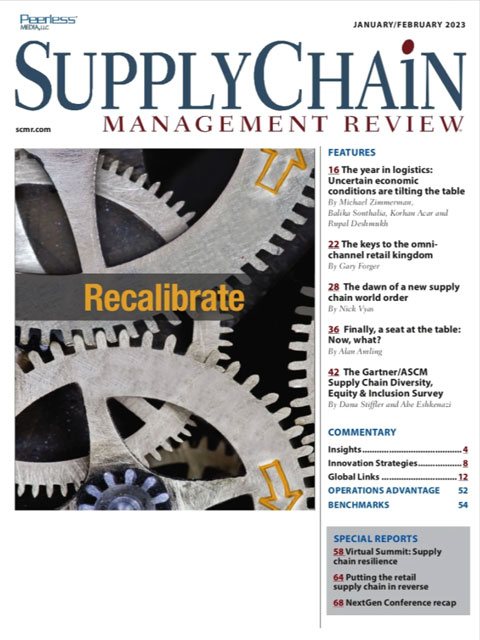Sorry, but your login has failed. Please recheck your login information and resubmit. If your subscription has expired, renew here.
January-February 2023
It feels like a normal holiday season. ”That was the report I got from the VP of global distribution at one of the country’s best known retail brands on the Monday before Black Friday. He added that the last time he felt that way was November of 2019. One of the perks of this job is that I get to talk to a lot of supply chain executives. In my conversations over the last year, I’ve learned two things. Operations, which was perhaps hardest hit at the start of the pandemic, has learned to operate in this new environment. Sure, there are still hiccups caused by absenteeism and inventory shortages. But those are situational—give them supply and… Browse this issue archive.Need Help? Contact customer service 847-559-7581 More options
With a war raging in Ukraine, persistent people and supply shortage, relentless disruptions, high interest rates and the threat of a recession, no one would blame chief supply chain officers in 2022 if they put a temporary hold on their diversity, equity and inclusion (DEI) efforts.
Instead, the results of the second annual Gartner/Association for Supply Chain Management DEI report, released last May, showed the strongest intent yet among supply chain organizations to support DEI, particularly for women and underrepresented races and ethnicities. Beyond the intent, new data cements previous findings that specific conditions and practices lead to superior pipelines and reported progress against DEI agendas.
We also see a chasm widening between global, publicly held companies and the rest in terms of commitment and results. With no letup in sight for a fiercely competitive talent landscape, supply chain leaders must deliver an equitable, inclusive employee experience. Otherwise, they may fail to secure the talent necessary to ensure that lines run, orders ship, and global supply chains run sustainably and profitably.
Given the tremendous pressures on global supply chains and our prediction that leaders would revert to old comfort zones, relationships and crisis-based HR hiring and promotion practices, we were surprised to see that focus across various dimensions of diversity increased. Compared to 2021, a significantly higher percentage of organizations across sectors, company types and regions reported a formal focus on diversity dimensions (see Figure 1). Today, more than 75% of supply chain organizations consider gender and ethnicity/race in their DEI strategies and objectives (up from 59% and 62%, respectively).
There has been a significant increase in companies focusing on many dimensions since 2021. While the most visible increases were in gender, race and ethnicity, physical ability and less visible dimensions like age, nationality and sexual orientation also grew in importance. We also saw a significant decrease in those that focused on no DEI dimensions: only 11% in 2022 versus 21% last year. Across our four industry sectors (shown in Figure 1), all increased their focus on ethnicity and race, gender and sexual orientation. Notably, industrial supply chain organizations significantly increased their focus on ethnicity/race and gender compared with 2021.
These increased levels of commitment to DEI make sense amid the new talent landscape. At 87%, attracting, retaining and engaging employees is the top reason for supply chain organizations having goals and objectives to increase diversity. Another 59% cite reflecting and supporting local communities as a reason they have DEI goals or objectives and 55% seek to improve business performance.
Across the sample, we saw slight progress on average, specifically when looking at representation of people of color in supply chain. The percentage of full-time employees that are people of color in supply chain has edged up slightly from 30% to 32% in the past year. We defined “people of color” as being Asian, Black/African/Afro-Caribbean, Hispanic/Latinx, Native American/First Nations, Pacific Islander, Middle Eastern and any other indigenous person, which are all underrepresented groups in Europe, the United States and Canada.
SC
MR
Sorry, but your login has failed. Please recheck your login information and resubmit. If your subscription has expired, renew here.
January-February 2023
It feels like a normal holiday season. ”That was the report I got from the VP of global distribution at one of the country’s best known retail brands on the Monday before Black Friday. He added that the last time… Browse this issue archive. Access your online digital edition. Download a PDF file of the January-February 2023 issue.With a war raging in Ukraine, persistent people and supply shortage, relentless disruptions, high interest rates and the threat of a recession, no one would blame chief supply chain officers in 2022 if they put a temporary hold on their diversity, equity and inclusion (DEI) efforts.
Instead, the results of the second annual Gartner/Association for Supply Chain Management DEI report, released last May, showed the strongest intent yet among supply chain organizations to support DEI, particularly for women and underrepresented races and ethnicities. Beyond the intent, new data cements previous findings that specific conditions and practices lead to superior pipelines and reported progress against DEI agendas.
We also see a chasm widening between global, publicly held companies and the rest in terms of commitment and results. With no letup in sight for a fiercely competitive talent landscape, supply chain leaders must deliver an equitable, inclusive employee experience. Otherwise, they may fail to secure the talent necessary to ensure that lines run, orders ship, and global supply chains run sustainably and profitably.
Given the tremendous pressures on global supply chains and our prediction that leaders would revert to old comfort zones, relationships and crisis-based HR hiring and promotion practices, we were surprised to see that focus across various dimensions of diversity increased. Compared to 2021, a significantly higher percentage of organizations across sectors, company types and regions reported a formal focus on diversity dimensions (see Figure 1). Today, more than 75% of supply chain organizations consider gender and ethnicity/race in their DEI strategies and objectives (up from 59% and 62%, respectively).
There has been a significant increase in companies focusing on many dimensions since 2021. While the most visible increases were in gender, race and ethnicity, physical ability and less visible dimensions like age, nationality and sexual orientation also grew in importance. We also saw a significant decrease in those that focused on no DEI dimensions: only 11% in 2022 versus 21% last year. Across our four industry sectors (shown in Figure 1), all increased their focus on ethnicity and race, gender and sexual orientation. Notably, industrial supply chain organizations significantly increased their focus on ethnicity/race and gender compared with 2021.
These increased levels of commitment to DEI make sense amid the new talent landscape. At 87%, attracting, retaining and engaging employees is the top reason for supply chain organizations having goals and objectives to increase diversity. Another 59% cite reflecting and supporting local communities as a reason they have DEI goals or objectives and 55% seek to improve business performance.
Across the sample, we saw slight progress on average, specifically when looking at representation of people of color in supply chain. The percentage of full-time employees that are people of color in supply chain has edged up slightly from 30% to 32% in the past year. We defined “people of color” as being Asian, Black/African/Afro-Caribbean, Hispanic/Latinx, Native American/First Nations, Pacific Islander, Middle Eastern and any other indigenous person, which are all underrepresented groups in Europe, the United States and Canada.
SC
MR


Latest Supply Chain News
- Few executives believe their supply chains can respond quickly to disruptions
- Technology’s role in mending supply chain fragility after recent disruptions
- Tech investments bring revenue increases, survey finds
- Survey reveals strategies for addressing supply chain, logistics labor shortages
- Israel, Ukraine aid package to increase pressure on aerospace and defense supply chains
- More News
Latest Podcast

 Explore
Explore
Business Management News
- Few executives believe their supply chains can respond quickly to disruptions
- Technology’s role in mending supply chain fragility after recent disruptions
- Survey reveals strategies for addressing supply chain, logistics labor shortages
- How CPG brands can deliver on supplier diversity promises
- How S&OP provides the answer to in-demand products
- AI, virtual reality is bringing experiential learning into the modern age
- More Business Management
Latest Business Management Resources

Subscribe

Supply Chain Management Review delivers the best industry content.

Editors’ Picks






 Download Article PDF
Download Article PDF
